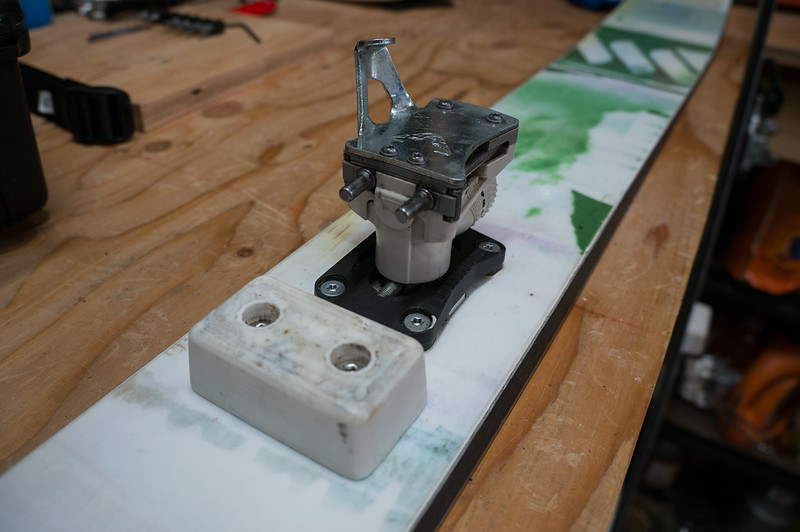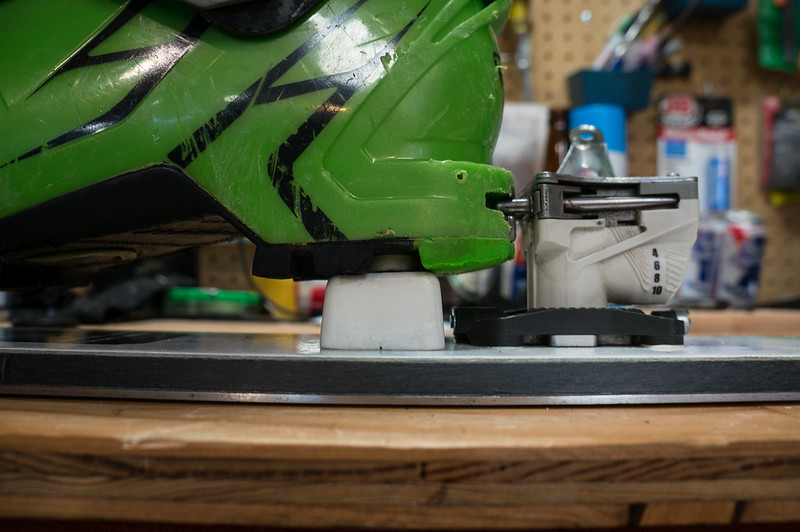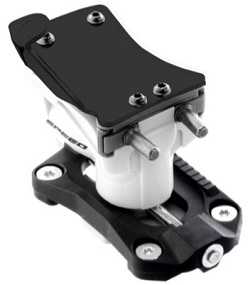Results 51 to 75 of 1311
Thread: The 300g Touring Binding Thread
-
12-05-2018, 08:58 AM #51
-
12-05-2018, 09:00 AM #52
-
12-05-2018, 09:48 AM #53
I believe I've felt a difference, but it is hard to say because I've only compared across binding/ski combos and not back to back. However, I'm certain when I blew heel pins on a huck, that transferring energy through brakes or a spacer would have likely saved the pins. Or another pair of Dynafits where the pins blew through the top of the Scarpa boot heel, I'd rather have that energy transfered to the ski. I deduce the same transfer might help my skiing when nondestructive forces are involved.
Forward travel (which is spring loaded) should theoretically supply some damping in its course of supporting expected release characteristics. You could call it elastic travel in ski flex but you'd rightly say that is a slight abuse of the term, but it does communicate the message. As I have not A-Bd underboot support for power transfer on the same binding model, I suspect you have not A-Bd the Ion with a binding that was identical except that it relied solely on a pin gap instead of forward travel? Sam Shaheen credited the forward travel of the Marker Alpinist to dampness in his Blister gear review.2) I’ve skied a lot of bindings with forward travel (what some of you are erroneously calling forward pressure), and can’t say that it does anything with respect to ‘smoothness’ in how a binding feels in rough snow (for example, I felt that the ION is one of the harshest bindings). Anyone that says otherwise I’d take that opinion with a grain of salt until you try it yourself. It DOES help with retention however.
@margotron here is how forward travel assists with retention:
When the ski decambers the straight line distance between the front and rear binding screws decreases slightly. If you have a heel gap on the pins like most tech bindings, the pins simply go further into the boot heel inserts to compensate for the distance. You can only have so much heel gap (or the pins hit the boot). So, if instead (Zed/Ion/Tecton/Vipec) or in addition (some ATKs) you have a spring loaded track that moves the binding heel back when pressured, this is "forward travel." On alpine bindings you also have "forward pressure" by applying preload to that spring so that when the ski gains extra "camber" in rebound (think in a hop turn) and the front and rear screws move farther away from each other, then the binding heel can move forward for consistency, but in tech bindings forward pressure is not used because modern heel pins compensate (they are usually long enough not to come out of the heel fitting except in extreme circumstance) and the boot is fixed to the binding at the toe, unlike in an alpine binding. (That is why vipecs/tectons/ions/zeds have no heel pin gap, but also have no extra pressure applied).
At a certain point, though, you could experience prerelease or inappropriate retention by too much decambering of the ski because the boot heel will bind and push against the binding heel causing it to bind or turn depending on design. Similarly, you can get a prerelease by too much temporary camber on rebound of loading ski causing the heel pins to to come out of the rear fitting which was a problem with older tech bindings like the Comfort which had shorter pins. Originally Posted by blurred
Originally Posted by blurred
-
12-05-2018, 10:05 AM #54
Dunno if I am that random person, but I based my claim on a boot in a speed radical on my workbench, where I could move the boot laterally quite a bit before the movement was transferred to the ski. I then installed ATK spacers and the this 'play' was gone. Again, on the workbench. So in that sense you are right that it is theoretical, although it did practically eliminate some slop. Did I feel a massive difference on snow? Can't really say I did. But I try to avoid skiing speed-rads inbounds, where I think one would notice the biggest change (i.e. edge to edge changes on a smooth groomer).
-
12-05-2018, 10:42 AM #55
I tend to think forward travel has little to do with why Ions, for example, ski better than Verticals or Radicals. Ions have less rotational play at the heel than Verticals and similar Dynafit bindings (and I'm not referring to increased play that develops as thimble bushings wear). If you grab Vertical or Radical 1.0 heel piece and wiggle it from side to side you will notice that you can move it with less effort than an Ion, Plum Guide or SSL 2.0 heel piece. I'm not talking full rotations, just a few degrees from side to side.
Bindings with less play feel more connected to the ski in certain types of turns on certain snow. It is subtle, but I noticed an increase in connectedness when switching bindings (on the same pair of skis) from Comforts to Plum Guides and from Speed Radicals to SSL 2.0's and Plum Race. I remember Marshall Olson years ago saying Plum Guides ski better than Verticals, and I thought it was BS since the former is essentially a copy of the latter. But he was right. Some folks may not notice this because of the way they ski, or they may not care. I liken it to switching from Dukes to, say, P18's. Some people will find little difference while others will notice a significant improvement, whether because of stack height or the way the Duke plate changes how a ski flexes.
I think the benefit of the spring loaded tech heel is real, but it lies in preventing a particular type of prerelease as described by Summit above. If you are a large human, tend to land hard off airs, or tour on soft-underfoot skis, you are more likely to benefit from forward travel. It's a bit like how some folks can force open lightly sprung tech toes on a hard turn, while others, even folks who weigh over 200 lbs., never have this issue.
Regarding SSL toe breakage: There are a lot of these toes out there, not only on SSL's and SSL 2's, but on variety if race bindings as well. And they've been around for a while. If it was a common problem we'd hear more about it. I certainly check mine regularly though.
-
12-05-2018, 11:06 AM #56
 Registered User
Registered User
- Join Date
- Sep 2010
- Location
- SW CO
- Posts
- 5,630
For the record: I wasn't trying to fear-monger, and I wasn't saying don't use the SSL 2.0. I was just saying *IF* you are concerned about it, it's easy to purchase SSL 2.0 heels and speed rad toes separately from skimo.co for about the same price as the SSL 2.0 with not much weight penalty. Frankly, the SSL 2.0 heel isn't that light so a few more grams at the toe doesn't bother me much. YMMV.
"Alpine rock and steep, deep powder are what I seek, and I will always find solace there." - Bean Bowers
photos
-
12-05-2018, 11:50 AM #57
Yup. I was just making it clear that those toes aren't as fatally flawed as Kingpin toes, OG Plum toes, or Radical 1.0 heels.
I actually have a Radical Toe, SSL 2.0 heel w/brakes Franken-binding, as well as 2 full pairs of SSL 2.0's I run brakeless. I put the Franken-binding on Zero G 108's which i ski pretty hard in funky condition, while the full SSL 2.0's are on some skinny, ultralight sticks and a pair of pow-touring skis which tend to see less in the way of impacts.
If I were the sort of person who breaks lots of ski gear, I would avoid the lighter toe altogether, because, why not? I think the weight penalty is 60 grams.
-
12-06-2018, 07:51 AM #58
I’m pretty sure it was someone else - a low post count non-regular.
It sounds like you have another definition of power transfer. By power transfer, I mean how much energy you can load up into the flex of a ski. As we’ve written, the Tecton and Kingpin are noticeably better here on firm snow.
What you’re talking about on the workbench MIGHT translate to a less vague feeling in the heel, but we really don’t know.
-
12-06-2018, 08:07 AM #59
I designed some 3D printed stomp blocks a couple years ago, but have since sold the setup. I was skiing a lot on the volcanoes then, and the block also served as a low riser for long sloggy slopes. I put inserts in the ski for easy block removal.



I noticed a more solid feel, even with the Speed Turn heel, which is of course designed to take pins-only forces. The boot just touched the block when clicked in. Probably made the lateral release less safe... shrug. They are probably minimally useful except for the hard-chargers. I liked them enough to run them all the time.
-
12-06-2018, 09:03 AM #60
-
12-06-2018, 09:06 AM #61
 Registered User
Registered User
- Join Date
- Jan 2014
- Location
- Gaperville, CO
- Posts
- 5,929
-
12-06-2018, 09:13 AM #62
Put brakes back on all my dynafits about 4 yrs ago and havent had a pre-release at the heel to insta-tele mode since. They *feel* more secure.
Move upside and let the man go through...
-
12-06-2018, 09:38 AM #63
I have recently mounted Zeds that I haven't skied on yet. The lateral tension on the heel piece doesn't seem to change when I adjust the DIN level. Feels like a lot of slop when I turn them side to side by hand. Am I thinking wrong about how it's supposed to work? Is it supposed to be a progressive spring tension or something? Or maybe there's a second adjustment that I'm missing? Unless I missed, the manual didn't indicate a second adjustment screw. Out of the box they were both set at 9 or 10, which seemed odd to me. I'm old and have big feet and bad knees, so I usually aim more for the 6.5 to 7.5 range.
-
12-06-2018, 09:40 AM #64
-
12-06-2018, 09:41 AM #65
 Registered User
Registered User
- Join Date
- Jan 2014
- Location
- Gaperville, CO
- Posts
- 5,929
Zeds only have one adjustment I believe -- and it adjust both vertical and lateral simultaneously.
-
12-06-2018, 09:42 AM #66
Yup, yup and yup. Norseman's pic is of >2018 Speed Turn heel. Starting sometime in 2017, Speed Turn 2.0 heels started coming with a black top plate with no button hole. The black top plate is a bit lighter and much easier to change modes with a ski pole. For older Turn heels, a B&D top plate + Comfort-style volcano is a worthy upgrade if you want to switch modes with your ski pole. (FWIW, for my older Turn and TLT Speed heels I fab my own Al alloy top plates for use with B&D Comfort-style volcanoes.:
Pic of newer Turn 2.0 heel with black top plate:

-
12-06-2018, 09:47 AM #67
 Registered User
Registered User
- Join Date
- Jan 2014
- Location
- Gaperville, CO
- Posts
- 5,929
If only Dynafit would sell a pairing of the radical toe (ideally with the gen 1 baseplate) and the speed turn heel w/ volcano.
-
12-06-2018, 09:49 AM #68
-
12-06-2018, 09:51 AM #69
 Registered User
Registered User
- Join Date
- Jan 2014
- Location
- Gaperville, CO
- Posts
- 5,929
-
12-06-2018, 11:25 AM #70
Do you know if the black top plate is backwards compatible with previous versions on the speed turn 2.0 heel (and if you can buy it separately)? Seems like Dynafit loves to tweak screw patterns...
I don't mind the silver version but my wife is bound to stab me with a ski pole at some point when she has to tour on her skinny sticks with the old-style binding, she can't rotate them to save her life.
-
12-06-2018, 11:28 AM #71
-
12-06-2018, 11:39 AM #72
 Registered User
Registered User
- Join Date
- Sep 2010
- Location
- SW CO
- Posts
- 5,630
I like the B&D ones — comfort plates + volcanos. Much easier to rotate. Direct replacement for the silver ones. My wife has them on her skis. Haven’t tried the new black ones, tho.
https://skimo.co/bnd-binding-parts"Alpine rock and steep, deep powder are what I seek, and I will always find solace there." - Bean Bowers
photos
-
12-06-2018, 11:52 AM #73
Top plate screw patterns are the same for TLT Speed, Speed Radical, Comfort, Vert, Turn, Turn 2.0, Classic and TriStep heels. I have no clue if the new black top plates are available. Maybe check Skimo.com
Yup, B&D Comfort top plate/volcano combo fits Turn, Turn 2.0 and TLT Speed heels. Have you tried the new Turn 2.0 black top plate? IME, they rotate with ski pole pretty well and there's no risk of volcano screws loosening. (IME, B&D volcano screws kinda suck.)
-
12-06-2018, 12:38 PM #74
 Registered User
Registered User
- Join Date
- Sep 2010
- Location
- SW CO
- Posts
- 5,630
No I haven't. I use SSL 2.0 heels exclusively at the moment. Haven't used the B&D top plate or volcano either, so good to know re screws loosening. And I'd prolly choose the Sally MTN or something lighter over the Turn 2.0 in the future. I'll take your word for it, though.
"Alpine rock and steep, deep powder are what I seek, and I will always find solace there." - Bean Bowers
photos
-
12-06-2018, 12:46 PM #75
Yeah, I may move to MTN if and when our Turn and Speed (hers -- I'm too big for flippers) setups shit the bed, although I don't see that happening soon. I replaced the pistons in one set of Turn heels last year and they function like new.



 Reply With Quote
Reply With Quote




Bookmarks